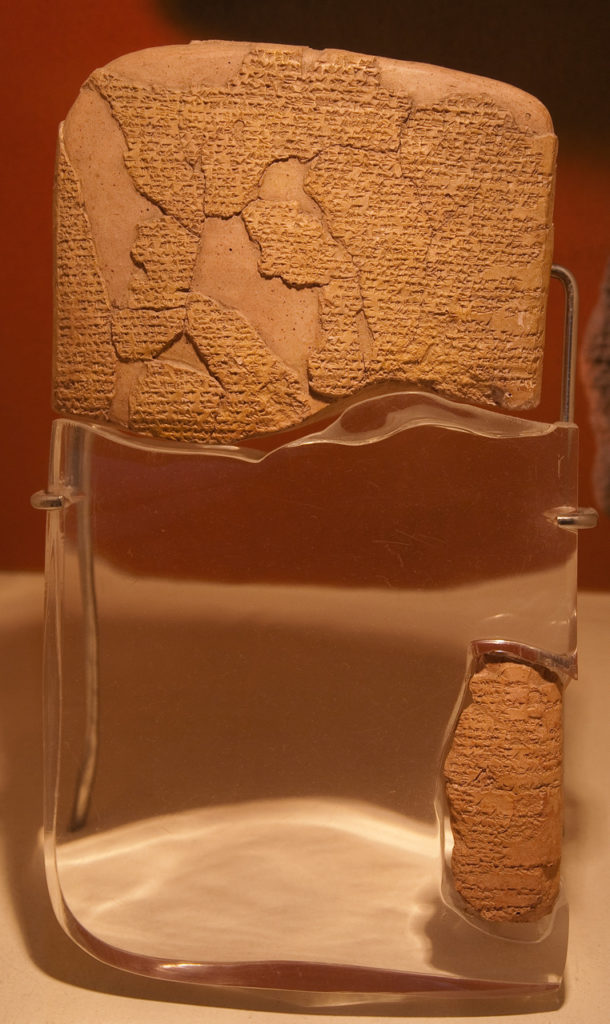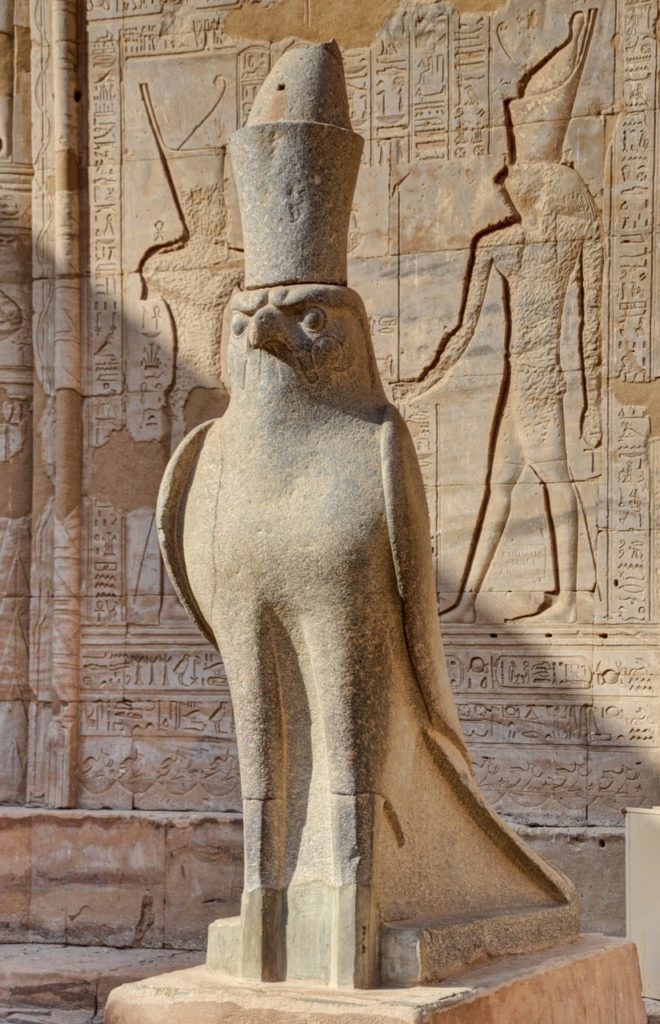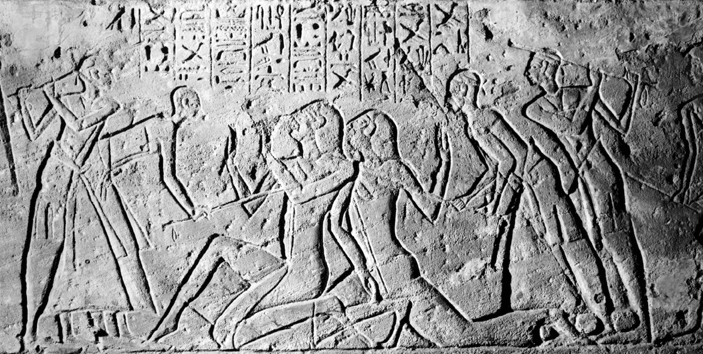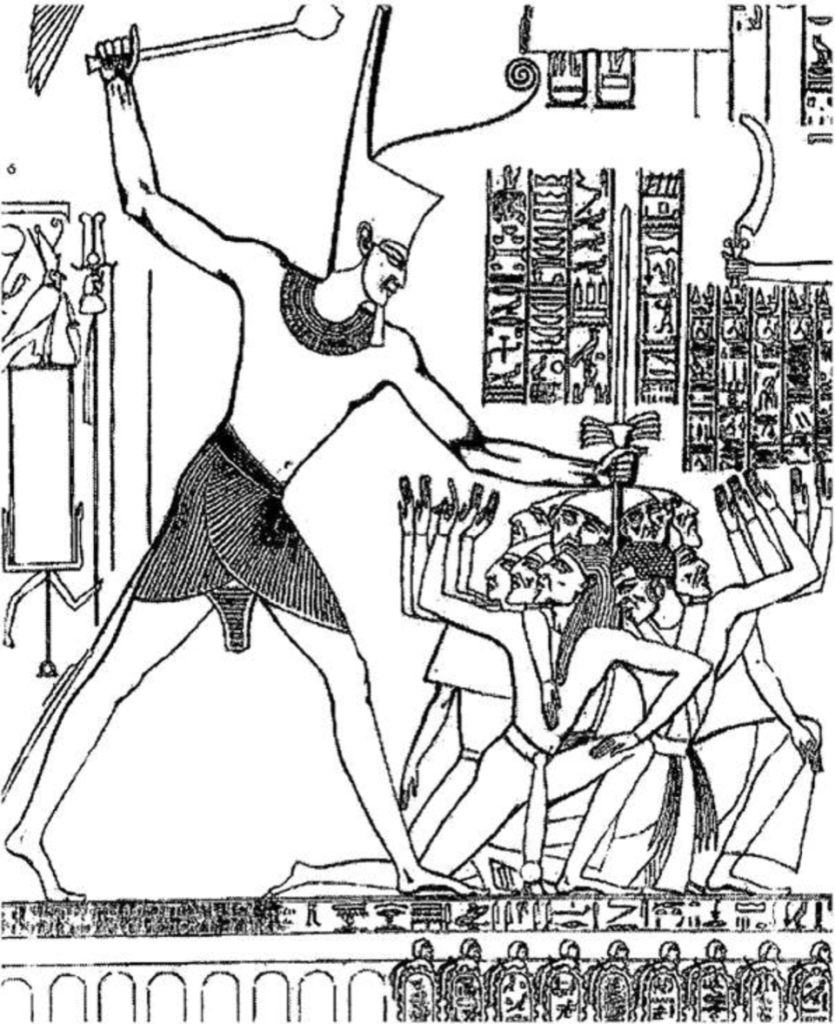An Old Testament KnoWhy[1]
Gospel Doctrine Lesson 13:
Bondage, Passover, and Exodus
(Exodus 1-3; 5-6; 11-14) (JBOTL13C)

Figure 1. Smaller Tablet of the Hittite version of a Peace Treaty with Egypt, executed ca. 1259 BCE, sixteen years after the battle of Kadesh. It “is believed to be the earliest example of any written international agreement of any kind.”[2]
Question: Most of the evidence for the historical Exodus comes indirectly from general archaeological findings and analysis of biblical texts. Is there any specific evidence for the reality and timing of the Exodus that can be corroborated from Egyptian sources?
Summary: Very possibly, but only indirectly. Although the Egyptians, like other ancient (and modern!) peoples, were understandably loathe themselves to truthfully advertise a military defeat, the Israelites had no qualms about publicizing such an event on their behalf. According to Hebrew Bible scholar Joshua Berman, the author of the “Sea Account,”[3] the oldest description of Israel’s final escape in the book of Exodus, may have intentionally imitated the structure and vocabulary of Egyptian propaganda trumpeting a claimed victory at the Battle of Kadesh in order to mock the pharaoh’s failure to stop the flight of the Israelites. Berman makes the case that the Israelite “Sea Account” must have been authored within a reasonable period of time after the battle of Kadesh by someone personally acquainted with the Egyptian inscriptions that reported it.
The Know

Figure 2. Falcon Representing Horus, protector of the pharaoh, at the Temple of Horus at Edfu. The pharaoh himself was also known as the “living” Horus, a god in his own right. Horus wears the pshent (double crown) representing the uniting of Upper and Lower Egypt.
Photograph by Stephen T. Whitlock
What Was the Battle of Kadesh? The Battle of Kadesh (1274 BCE), fought between the Egyptians and the Hittites, is perhaps “the best documented battle in all of ancient history:”[4]
[Ramesses II’s] army crossed the Egyptian border in the spring of year five of his reign and, after a month’s march, reached the area of Kadesh from the south.
The Hittite king Muwatalli … had positioned his troops behind “Old Kadesh,” but Ramesses, misled by two spies whom the Egyptians had captured, thought the Hittite forces were still far off, at Aleppo, and ordered his forces to set up camp.
The ensuing battle “is believed to have been the largest chariot battle ever fought, involving between 5,000 and 6,000 chariots in total.”[5]
Although the battle is well-documented, the several accounts telling of Egyptian victory are written by the Egyptians themselves and contain the usual exaggerations of phraraonic propaganda.[6] “Hittite records from Boghazkoy … tell of a very different conclusion to the greater campaign, where a chastened Ramesses was forced to depart from Kadesh in defeat.”[7]

Figure 3. Ramesses II Leads the Counterattack Against the Hittites in the Battle of Kadesh, ca. 1275 BCE.
Relief from the Great Temple at Abu Simbel[8]
Was the “Sea Account” of Exodus written in a style that mocks Egypt’s victory at Kadesh? According to Joshua Berman,[9] the answer is “yes.” He has argued that the Bible’s oldest version of the story of the Israelites’ final escape from the Egyptians,[10] like the story of the ten plagues highlighted in a previous article in this series, was written as a sort of parody. Unlike more common sorts of parodies, the imitation was not intended for comic effect.[11] Rather, if Berman’s arguments hold, the purpose of the imitation may have been to highlight the contrast between the leaders of Egypt and Israel, undermining the supposed supremacy of pharaoh and his gods and showing how the God of Israel, at every turn of events, can be seen as shattering false Egyptian pretensions while revealing Jehovah’s true greatness and glory. Specifically, whereas monumental accounts of the battle of Kadesh portray Ramesses II as a godlike figure leading a counterattack against the Hittites, the book of Exodus turns the table mockingly on the Egyptians by describing the Israelites’ divinely led victory against them using similar descriptions.

Figure 4. Shasu Spies Being Beaten by Egyptians for Falsely Reporting the Whereabouts of Hittite Troops.[12]
The image recalls the accusations of spying leveled by Joseph at his brothers (Genesis 42:9-16)
Berman summarizes similarities between the Egyptian and Exodus accounts as follows:[13]
The protagonist army breaks ranks at the sight of the enemy chariot force. A plea for divine help is answered with encouragement to move forward, and victory is assured. On the battlefield itself, the protagonist king encounters the enemy chariots with fire. The enemy chariotry seeks to flee and recognizes, by name, the divine force that attacks it. Many meet their death in water, and there are no survivors. The king’s troops return to survey the enemy corpses and are amazed at the king’s accomplishment. They offer the king a victory hymn. It includes praise of his name, references to his strong arms, and notes that he is their source of strength and the source of their salvation. The enemy is compared to chaff, while the king is deemed without peer in battle. He leads his troops peacefully home, intimidating foreign lands along the way. The king arrives at his palace, and is granted eternal rule. This is the story of Ramesses II in the Kadesh Poem, and this is the story of YHWH [Jehovah] in the account of the sea in Exodus 14–15.

Figure 5. Corpses of the Drowned Hittites in the Orontes River with
Heroic Image of Pharaoh with His Newly Refashioned Bow and Chariot[14]
Remarking on the common element in both accounts where “the enemy sinks into the water and perishes,” Berman writes:[15]
This, of course, is central to the sea account of Exodus 14–15. The sinking or submerging of the enemy is emphasized in the Song at [Exodus] 15:4, 5, and 10. To be sure, the Kadesh Poem does not tell of wind-swept seas overpowering the Hittites; but they do submerge into a body of water — the Orontes River — and many perish there. Ramesses claims (P138–140) that in their haste to escape his onslaught, the Hittites “plunged” into the river, seeking refuge “like crocodiles.” Ramesses claims that he slaughtered them there in the water. The reliefs draw attention to the drowning of the Hittites in vivid fashion.
Both texts underscore that there were no survivors in the water. The Poem states, (P141) “None looked behind him, no other turned around. (P142) Whoever of them fell, he did not rise again.” Exod 14:28 states, “The waters turned back and covered the chariots and the horsemen … not one of them remained.”

Figure 6. Relief of Seti I (13th c. BCE) with raised right hand, shattering the heads of his enemies,
Hypostyle Hall at Karnak[16]
Victory through a “mighty arm.” In addition to similar structure and story themes, Berman points to specific terms common in the two accounts but rare elsewhere in scripture. As one example, he points out the use of “mighty arm”:[17]
In [both the Egyptian and Israelite accounts], the timid troops see evidence of the king’s “mighty arm,” review the enemy corpses, and, amazed by the sovereign’s achievement, are impelled to sing a hymn of praise. In the Kadesh poem we read:
Then when my troops and chariotry saw me, that I was like Montu , my arm strong, . . . then they presented themselves one by one, to approach the camp at evening time. They found all the foreign lands, among which I had gone, lying overthrown in their blood . … I had made white [with their corpses] the countryside of the land of Kadesh. Then my army came to praise me, their faces [amazed/averted] at seeing what I had done.
Exodus 14:30-31 is remarkably similar, and in two cases identical:
Israel saw the Egyptians dead on the shore of the sea. And when Israel saw the great hand which the Lord had wielded against the Egyptians, the people feared the Lord.
As I noted earlier, “great hand” here and “great arm” in 15:16 are used exclusively in the Hebrew Bible with regard to the exodus, a trope found elsewhere only within Egyptian propaganda, especially during the late second-millennium New Kingdom.
After the great conquest, in both accounts, the troops offer a paean to the king. In each, the opening stanza comprises three elements. The troops laud the king’s name as a warrior; credit him with stiffening their morale; and exalt him for securing their salvation. In the Kadesh poem we read:
My officers came to extol my strong arm and likewise my chariotry, boasting of my name thus: “What a fine warrior, who strengthens the heart/That you should rescue your troops and chariotry!”
And here are the same motifs in the opening verses of the Song at the Sea:[18]
Then Moses and the Israelites sang this song to the Lord. . … “The Lord is my strength and might; He is become my salvation … the Lord, the Warrior — Lord is His name!”
In both the poem and in Exodus, praise of the victorious sovereign continues in a double strophe extolling his powerful hand or arm. The poem: “You are the son of Amun, achieving with his arms, you devastate the land of Hatti by your valiant arm.” The Song:[19] “Your right hand, O Lord, glorious in power, Your right hand, O Lord, shatters the foe!”
[Also note that] the Hebrew root for the right hand (ymn) is common to a variety of other ancient Near Eastern languages. Yet in those other cultures, the right hand is linked exclusively with holding or grasping. In Egyptian literature, however, we find depictions of the right hand that match those in the Song. Perhaps the most ubiquitous motif of Egyptian narrative art is the pharaoh raising his right hand to shatter the heads of enemy captives.
This Egyptian royal image endured from the third millennium down into the Christian era. In no other ancient Near Eastern culture do we encounter such portrayals of the right hand, which resonate closely with the Song and particularly with [Exodus] 15:6: “Your right hand, O Lord, shatters the enemy.”
The Why
If Berman’s conclusion about the dependence of Exodus Sea Account on the Egyptian battle of Kadesh inscriptions holds true, it may provide clues both to the dating of the earliest account of the Exodus and also to the timeframe of the Exodus itself. The significance of this finding is best described by Berman himself:[20]
One possibility might be that the poem reached Israel in a period of amicable relations with Egypt, perhaps during the reign of Solomon in the 10th century or, still later, of Hezekiah in the 8th. Counting against this, though, is that the latest copies of the Kadesh poem in our possession are from the 13th century, and there are no explicit references to it, or any clear attempts to imitate it, in later Egyptian literature. Moreover, we have no epigraphic evidence that any historical inscriptions from ancient Egypt ever reached Israel or the southern kingdom of Judah, either in the Egyptian language or in translation. And this leaves aside the puzzle of what, in a period of entente, would have motivated an Israelite scribe to pen an explicitly anti-Egyptian work in the first place.
To determine a plausible date of transmission, we should be guided by the epigraphic evidence at hand. Egyptologists note that in addition to copies of the monumental version of the Kadesh poem, a papyrus copy was found in a village of workmen and artisans who built the great monuments at Thebes. As we saw earlier, visual accounts of the battle were also produced. This has led many scholars of ancient Egypt to argue that the Kadesh poem was a widely disseminated “little red book,”[21] aimed at stirring public adoration of the valor and salvific grace of Ramesses the Great, and that it would have been widely known, particularly during the reign of Ramesses himself, beyond royal and temple precincts. …
Some might conclude that the plot line of the Kadesh poem reached Israel under conditions hidden to us and, for reasons we cannot know, became incorporated into the text of Exodus many centuries down the line. Others will regard the parallels as one big coincidence. But my own conclusion is otherwise: the evidence adduced here can be reasonably taken as indicating that the poem was transmitted during the period of its greatest diffusion, which is the only period when anyone in Egypt seems to have paid much attention to it: namely, during the reign of Ramesses II himself. In my view, the evidence suggests that the Exodus text preserves the memory of a moment when the earliest Israelites reached for language with which to extol the mighty virtues of God, and found the raw material in the terms and tropes of an Egyptian text well-known to them. In appropriating and “transvaluing” that material, they put forward the claim that the God of Israel had far outdone the greatest achievement of the greatest earthly potentate.
As always, I appreciate the love, support, and advice of Kathleen M. Bradshaw on this article. Thanks also to Stephen T. Whitlock for allowing me to include his photograph of Horus and for other valuable suggestions.
Further Study
For an insightful exploration of how the Exodus served as a type for Book of Mormon stories of deliverance, see S. K. Brown, Exodus Pattern.
I first became acquainted with Joshua Berman’s remarkable findings on the possibile appropriation of official Egyptian accounts of the battle of Kadesh in Exodus through one of a series of lectures he gave at Brigham Young University on October 8, 2015. Unfortunately, the lecture, entitled “The Kadesh Inscriptions of Ramesses II and the Exodus Sea Account,” appears not to have been recorded. However, he presents a three-minute synopsis of his ideas in “A Passover Story: Archaeology and the Exodus,” https://www.youtube.com/watch?v=ZOGeusWwI-g. For more extensive, written versions of his arguments, see J. A. Berman, Was There an Exodus?; J. A. Berman, Inconsistency.
For a video describing the historical context and weapon technology of the battle of Kadesh, see Ancient Discoveries: Egyptian Warfare (History Channel), https://www.youtube.com/watch?v=SS3eQbQG5mA.
For other scripture resources relating to this lesson, see The Interpreter Foundation Old Testament Gospel Doctrine Index (https://dev.interpreterfoundation.org/gospel-doctrine-resource-index/ot-gospel-doctrine-resource-index/) and the Book of Mormon Central Old Testament KnoWhy list (https://knowhy.bookofmormoncentral.org/tags/old-testament).
References
Ancient Discoveries: Egyptian Warfare (History Channel). 2006. In YouTube. https://www.youtube.com/watch?v=SS3eQbQG5mA. (accessed April 14, 2018).
Berman, Joshua A. 2015. Searching for the historical Exodus (2 April 2015). In The Wall Street Journal. https://www.wsj.com/articles/joshua-berman-searching-for-the-historical-exodus-1428019901. (accessed March 29, 2018).
———. 2015. Was there an Exodus? In Mosaic Magazine. http://mosaicmagazine.com/essay/2015/03/was-there-an-exodus/. (accessed June 27, 2015).
———. Inconsistency in the Torah: Ancient Literary Convention and the Limits of Source Criticism. Oxford, England: Oxford University Press, 2017.
Brown, S. Kent. "The Exodus pattern in the Book of Mormon." In From Jerusalem to Zarahemla: Literary and Historical Studies of the Book of Mormon, edited by S. Kent Brown, 75-98. Provo, UT: Religious Studies Center, Brigham Young University, 1998. https://rsc.byu.edu/archived/jerusalem-zarahemla-literary-and-historical-studies-book-mormon/exodus-pattern-book-mormon. (accessed April 7, 2018).
Homan, Michael M. "The divine warrior in his tent: A military model for Yahweh’s tabernacle." Bible Review 16, no. 6 (December 2000). https://members.bib-arch.org/bible-review/16/6/8. (accessed March 31, 2018).
Nibley, Hugh W. 1975. The Message of the Joseph Smith Papyri: An Egyptian Endowment. 2nd ed. Salt Lake City, UT: Deseret Book, 2005.
Endnotes
Interesting resemblances of “imitation” Egyptian temple architecture and rites to their authentic equivalents will be discussed in the next article in this series.


